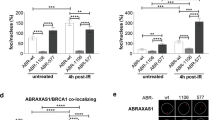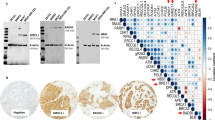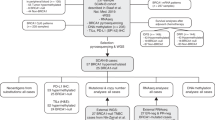Abstract
The ataxia-telangiectasia-mutated (ATM) kinase is a key transducer of DNA damage signals within the genome maintenance machinery and a tumour suppressor whose germline mutations predispose to familial breast cancer. ATM signalling is constitutively activated in early stages of diverse types of human malignancies and cell culture models in response to oncogene-induced DNA damage providing a barrier against tumour progression. As BRCA1 and BRCA2 are also components of the genome maintenance network and their mutations predispose to breast cancer, we have examined the ATM expression in human breast carcinomas of BRCA1/2 mutation carriers, sporadic cases and familial non-BRCA1/2 patients. Our results show that ATM protein expression is aberrantly reduced more frequently among BRCA1 (33%; P=0.0003) and BRCA2 (30%; P=0.0009) tumours than in non-BRCA1/2 tumours (10.7%). Furthermore, the non-BRCA1/2 tumours with reduced ATM expression were more often estrogen receptor (ER) negative (P=0.0002), progesterone receptor (PR) negative (P=0.004) and were of higher grade (P=0.0004). In our series of 1013 non-BRCA1/2 cases, ATM was more commonly deficient (20%; P=0.0006) and p53 was overabundant (47%; P<0.0000000001) among the difficult-to-treat ER/PR/ERBB2-triple-negative subset of tumours compared with cases that expressed at least one of these receptors (10 and 16% of aberrant ATM and p53, respectively). We propose a model of ‘conditional haploinsufficiency’ for BRCA1/2 under conditions of enhanced DNA damage in precancerous lesions resulting in more robust activation and hence increased selection for inactivation or loss of ATM in tumours of BRCA1/2 mutation carriers, with implications for genomic instability and curability of diverse subsets of human breast cancer.
This is a preview of subscription content, access via your institution
Access options
Subscribe to this journal
Receive 50 print issues and online access
$259.00 per year
only $5.18 per issue
Buy this article
- Purchase on Springer Link
- Instant access to full article PDF
Prices may be subject to local taxes which are calculated during checkout


Similar content being viewed by others
References
Angele S, Treilleux I, Bremond A, Taniere P, Hall J . (2003). Altered expression of DNA double-strand break detection and repair proteins in breast carcinomas. Histopathology 43: 347–353.
Bartek J, Lukas J . (2007). DNA damage checkpoints: from initiation to recovery or adaptation. Curr Opin Cell Biol 19: 238–245.
Bartek J, Lukas C, Lukas J . (2004). Checking on DNA damage in S phase. Nat Rev Mol Cell Biol 5: 792–804.
Bartek J, Lukas J, Bartkova J . (2007). DNA damage response as an anti-cancer barrier. Damage threshold and the concept of ‘conditional haploinsufficiency’. Cell Cycle 6: 2344–2347.
Bartkova J, Bakkenist CJ, Rajpert-De Meyts E, Skakkebæk NE, Sehested M, Lukas J et al. (2005b). ATM activation in normal human tissues and testicular cancer. Cell Cycle 4: 838–845.
Bartkova J, Hořejší Z, Koed K, Kramer A, Tort F, Zieger K et al. (2005a). DNA damage response as a candidate anti-cancer barrier in early human tumorigenesis. Nature 434: 864–870.
Bartkova J, Rezaei N, Liontos M, Karakaidos P, Kletsas D, Issaeva N et al. (2006). Oncogene-induced senescence is part of the tumorigenesis barrier imposed by DNA damage checkpoints. Nature 444: 633–637.
Bryant HE, Schultz N, Thomas HD, Parker KM, Flowed D, Lopez E et al. (2005). Specific killing of BRCA2-deficient tumours with inhibitors of poly(ADP-ribose) polymerase. Nature 434: 913–917.
Cleator S, Heller W, Coombes RC . (2007). Triple-negative breast cancer: therapeutic options. Lancet Oncol 8: 235–244.
Cortez D, Wang Y, Qin J, Elledge SJ . (1999). Requirement of ATM-dependent phosphorylation of brca1 in the DNA damage response to double-strand breaks. Science 286: 1162–1166.
Di Micco R, Fumagalli M, Cicalese A, Piccini S, Gasparini P, Luise C et al. (2006). Oncogene-induced senescence is a DNA damage response triggered by DNA hyper-replication. Nature 444: 638–642.
Eerola H, Blomqvist C, Pukkala E, Pyrhonen S, Nevanlinna H . (2000). Familial breast cancer in Southern Finland: how prevalent are breast cancer families and can we trust the family history reported by the patients? Eur J Cancer 36: 1143–1148.
Eerola H, Heikkila P, Tamminen A, Aittomaki K, Blomqvist C, Nevanlinna H . (2005a). Histopathological features of breast tumours in BRCA1, BRCA2 and mutation-negative breast cancer families. Breast Cancer Res 7: R93–R100.
Eerola H, Heikkila P, Tamminen A, Aittomaki K, Blomqvist C, Nevanlinna H . (2005b). Relationship of patients' age to histopathological features of breast tumours in BRCA1 and BRCA2 and mutation-negative breast cancer families. Breast Cancer Res 7: R465–R469.
Elston CW, Ellis IO . (1991). Pathological prognostic factors in breast cancer. I. The value of histological grade in breast cancer: experience from a large study with long-term follow-up. Histopathology 19: 403–410.
Farmer H, McCabe N, Lord CJ, Tutt AN, Johnson DA, Richardson TB et al. (2005). Targeting the DNA repair defect in BRCA mutant cells as a therapeutic strategy. Nature 434: 917–921.
Gorgoulis VG, Vassiliou LV, Karakaidos P, Zacharatos P, Kotsinas A, Liloglou T et al. (2005). Activation of the DNA damage checkpoint and genomic instability in human precancerous lesions. Nature 434: 907–913.
Honrado E, Benitez J, Palacios J . (2005). The molecular pathology of hereditary breast cancer: genetic testing and therapeutic implications. Mod Pathol 18: 1305–1320.
Iggo R, Gatter K, Bartek J, Lane DP, Harris AL . (1990). Increased expression of mutant forms of p53 oncogene in primary lung cancer. Lancet 335: 675–679.
Kastan M, Bartek J . (2004). Cell-cycle checkpoints and cancer. Nature 432: 316–323.
Kilpivaara O, Bartkova J, Eerola H, Syrjakoski K, Vahteristo P, Lukas J et al. (2005). Correlation of CHEK2 protein expression and c.1100delC mutation status with tumor characteristics among unselected breast cancer patients. Int J Cancer 113: 575–580.
Lassus H, Leminen A, Vayrynen A, Cheng G, Gustafsson JA, Isola J et al. (2004). ERBB2 amplification is superior to protein expression status in predicting patient outcome in serous ovarian carcinoma. Gynecol Oncol 92: 31–39.
Lukas C, Bartkova J, Latella L, Falck J, Mailand N, Schroeder T et al. (2001). DNA damage-activated kinase Chk2 is independent of proliferation or differentiation yet correlates with tissue biology. Cancer Res 61: 4990–4993.
Mallette FA, Gaumont-Leclerc MF, Ferbeyre G . (2007). The DNA damage signalling pathway is a critical mediator of oncogene-induced senescence. Genes Dev 21: 43–48.
Matsuoka S, Ballif BA, Smogorzewska A, McDonald III ER, Hurov KE, Luo J et al. (2007). ATM and ATR substrate analysis reveals extensive protein networks responsive to DNA damage. Science 316: 1160–1166.
McCabe N, Turner NC, Lord CJ, Kluzek K, Bialkowska A, Swift S et al. (2006). Deficiency in the repair of DNA damage by homologous recombination and sensitivity to Poly(ADP-ribose) polymerase inhibition. Cancer Res 66: 8109–8115.
Palacios J, Honrado E, Osorio A, Cazorla A, Sarrio D, Barroso A et al. (2003). Immunohistochemical characteristics defined by tissue microarray of hereditary breast cancer not attributable to BRCA1 or BRCA2 mutations: differences from breast carcinomas arising in BRCA1 and BRCA2 mutation carriers. Clin Cancer Res 9: 3606–3614.
Perou CM, Sorlie T, Eisen MB, van de Rijn M, Jeffrey SS, Rees CA et al. (2000). Molecular portraits of human breast tumours. Nature 406: 747–752.
Prokopcova J, Kleibl Z, Banwell CM, Pohlreich P . (2007). The role of ATM in breast cancer development. Breast Cancer Res Treat 104: 121–128.
Pylkas K, Tommiska J, Syrjakoski K, Kere J, Gatei M, Waddell N et al. (2007). Evaluation of the role of Finnish ataxia-telangiectasia mutations in hereditary predisposition to breast cancer. Carcinogenesis 28: 1040–1045.
Renwick A, Thompson D, Seal S, Kelly P, Chagtai T, Ahmed M et al. (2006). ATM mutations that cause ataxia-telangiectasia are breast cancer susceptibility alleles. Nat Genet 38: 873–875.
Shiloh Y . (2003). ATM and related protein kinases: safeguarding genome integrity. Nat Rev Cancer 3: 155–168.
Sorlie T, Perou CM, Tibshirani R, Aas T, Geisler S, Johnsen H et al. (2001). Gene expression patterns of breast carcinomas distinguish tumor subclasses with clinical implications. Proc Natl Acad Sci USA 98: 10869–10874.
Syrjäkoski K, Vahteristo P, Eerola H, Tamminen A, Kivinummi K, Sarantaus L et al. (2000). Population-based study of BRCA1 and BRCA2 mutations in 1035 unselected Finnish breast cancer patients. J Natl Cancer Inst 92: 1529–1531.
Tanner M, Gancberg D, Di Leo A, Larsimont D, Rouas G, Piccart MJ et al. (2000). Chromogenic in situ hybridization: a practical alternative for fluorescence in situ hybridization to detect HER-2/neu oncogene amplification in archival breast cancer samples. Am J Pathol 157: 1467–1472.
Tommiska J, Eerola H, Heinonen M, Salonen L, Kaare M, Tallila J et al. (2005). Breast cancer patients with p53 Pro72 homozygous genotype have a poorer survival. Clin Cancer Res 11: 5098–5103.
Turner N, Tutt A, Ashworth A . (2004). Hallmarks of ‘BRCAness’ in sporadic cancers. Nat Rev Cancer 4: 814–819.
Vahteristo P, Bartkova J, Eerola H, Syrjakoski K, Ojala S, Kilpivaara O et al. (2002). A CHEK2 genetic variant contributing to a substantial fraction of familial breast cancer. Am J Hum Genet 71: 432–438.
Vahteristo P, Eerola H, Tamminen A, Blomqvist C, Nevanlinna H . (2001). A probability model for predicting BRCA1 and BRCA2 mutations in breast and breast–ovarian cancer families. Br J Cancer 84: 704–708.
Vehmanen P, Friedman L, Eerola H, McClure M, Ward B, Sarantaus L et al. (1997). Low proportion of BRCA1 and BRCA2 mutations in Finnish breast cancer families: strong evidence for additional susceptibility genes. Hum Mol Genet 6: 2309–2315.
Ziv Y, Bielopolski D, Galanty Y, Lukas C, Taya Y, Schultz DC et al. (2006). Chromatin relaxation in response to DNA double strand breaks: a novel ATM- and KAP-1-dependent pathway. Nat Cell Biol 8: 870–876.
Acknowledgements
This study was supported by the Helsinki University Central Hospital Research Fund, Academy of Finland (110663), Finnish Cancer Society, the Sigrid Juselius Foundation, the Research and Science Foundation of Farmos, the Emil Aaltonen Foundation, the Danish Cancer Society, the Danish National Research Fund, the Danish Centre for Translational Breast Cancer Research, MSMT (Grant no. 6198959216) and the European Commission (integrated projects ‘Active p53’, ‘DNA repair’ and ‘Mutant p53’).
Author information
Authors and Affiliations
Corresponding authors
Additional information
Supplementary Information accompanies the paper on the Oncogene website (http://www.nature.com/onc).
Supplementary information
Rights and permissions
About this article
Cite this article
Tommiska, J., Bartkova, J., Heinonen, M. et al. The DNA damage signalling kinase ATM is aberrantly reduced or lost in BRCA1/BRCA2-deficient and ER/PR/ERBB2-triple-negative breast cancer. Oncogene 27, 2501–2506 (2008). https://doi.org/10.1038/sj.onc.1210885
Received:
Revised:
Accepted:
Published:
Issue Date:
DOI: https://doi.org/10.1038/sj.onc.1210885
Keywords
This article is cited by
-
ATM kinase regulates tumor immunoreactions in lymphocyte-predominant breast cancer through modulation of NKG2D ligand and TNF cytokines on tumor cells
Medical Molecular Morphology (2020)
-
Simultaneous ATM/BRCA1/RAD51 expression variations associated with prognostic factors in Iranian sporadic breast cancer patients
Breast Cancer (2017)
-
Low ATM protein expression in malignant tumor as well as cancer-associated stroma are independent prognostic factors in a retrospective study of early-stage hormone-negative breast cancer
Breast Cancer Research (2015)
-
Phase II/III weekly nab-paclitaxel plus gemcitabine or carboplatin versus gemcitabine/carboplatin as first-line treatment of patients with metastatic triple-negative breast cancer (the tnAcity study): study protocol for a randomized controlled trial
Trials (2015)
-
Transcriptome analysis of breast cancer in African American women
BMC Bioinformatics (2015)



